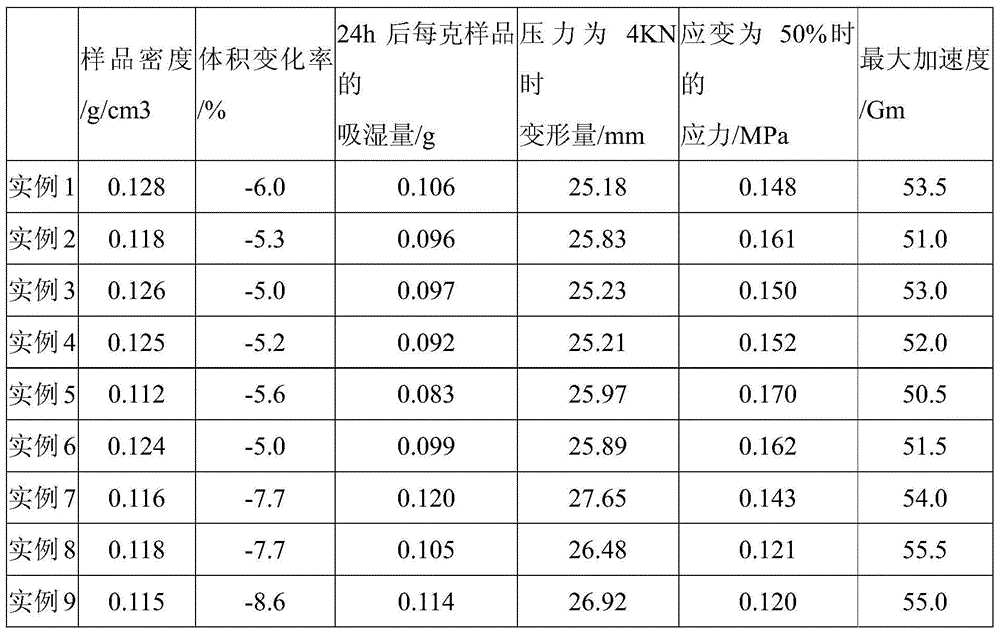Micronized plant fiber buffer material and preparation method thereof
A plant fiber and cushioning material technology, applied in the field of packaging cushioning materials, can solve the problems of uneven distribution, high cost, unsatisfactory foaming effect of foaming process, etc., to improve structural strength and cushioning performance, and the ability to absorb external energy Good, good sample forming effect
- Summary
- Abstract
- Description
- Claims
- Application Information
AI Technical Summary
Problems solved by technology
Method used
Image
Examples
example 1
[0025] Example 1, the preparation process is as follows:
[0026] (1) Take 30g of bagasse bleached pulp calculated as dry pulp, add 500g of water to soak for 4.5h under normal temperature conditions, dissociate the pulp for 10min through a disintegrator, and dehydrate it by suction to a pulp concentration of 20%; then weigh the mass of the pulp , add water to dilute to a pulp concentration of 10%; then use a PFI mill to beat the slurry with a pulp concentration of 10% to obtain micronized plant fibers with a beating degree of 73°SR.
[0027] (2) Dissolve 9.2g of cationic starch and 1.5g of polyvinyl alcohol in 200g of water, gelatinize at 90°C for 30 minutes, and cool to room temperature to obtain gelatinized cationic starch and polyvinyl alcohol.
[0028] (3) Add 20.8g of micronized plant fiber and 0.5g of magnesium stearate into the above cationic starch and polyvinyl alcohol gelatin and stir evenly; then add 9.0g of NaHCO 3 , mix well and let stand for 2 minutes, pour into...
example 2
[0030] Example 2, the preparation process is as follows:
[0031] (1) Take 30g of bagasse bleached pulp calculated as absolute dry pulp, add 500g of water to soak for 4.5h at room temperature, dissociate the pulp for 10min through a disintegrator, and dehydrate it by suction to a pulp concentration of 30%; then weigh the mass of the pulp , add water to dilute to a pulp concentration of 10%; then use a PFI mill to beat the slurry with a pulp concentration of 10% to obtain micronized plant fibers with a beating degree of 75°SR.
[0032] (2) Dissolve 6.0 g of cationic starch and 1.5 g of polyvinyl alcohol in 220 g of water, gelatinize at 90°C for 26 minutes, and cool to room temperature to obtain gelatinized cationic starch and polyvinyl alcohol.
[0033] (3) Add 24.0g of micronized plant fiber and 1.0g of magnesium stearate into the gelatinized cationic starch and polyvinyl alcohol in the previous step and stir evenly; then add 11.0g of NaHCO 3 , mix well and let stand for 2 mi...
example 3
[0035] Example 3, the preparation process is as follows:
[0036] (1) Take 30g of bagasse bleached pulp calculated as absolute dry pulp, add 500g of water to soak for 4.5h at room temperature, dissociate the pulp for 10min through a disintegrator, and dehydrate it by suction to a pulp concentration of 25%; then weigh the mass of the pulp , add water to dilute to a pulp concentration of 10%; then use a PFI mill to beat the slurry with a pulp concentration of 10% to obtain micronized plant fibers with a beating degree of 70°SR.
[0037] (2) Dissolve 7.6g of cationic starch and 1.5g of polyvinyl alcohol in 210g of water, gelatinize at 90°C for 28 minutes, and cool to room temperature to obtain gelatinized cationic starch and polyvinyl alcohol.
[0038] (3) Add 22.4g of micronized plant fiber and 0.5g of magnesium stearate into the cationic starch and polyvinyl alcohol gelatinized product in the previous step and stir evenly; then add 9.0g of NaHCO 3 , mix well and let stand for ...
PUM
 Login to View More
Login to View More Abstract
Description
Claims
Application Information
 Login to View More
Login to View More - R&D
- Intellectual Property
- Life Sciences
- Materials
- Tech Scout
- Unparalleled Data Quality
- Higher Quality Content
- 60% Fewer Hallucinations
Browse by: Latest US Patents, China's latest patents, Technical Efficacy Thesaurus, Application Domain, Technology Topic, Popular Technical Reports.
© 2025 PatSnap. All rights reserved.Legal|Privacy policy|Modern Slavery Act Transparency Statement|Sitemap|About US| Contact US: help@patsnap.com


